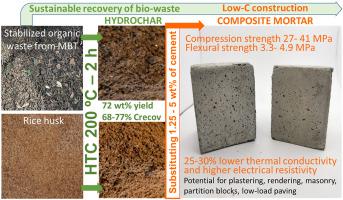Journal of Building Engineering ( IF 6.4 ) Pub Date : 2023-06-01 , DOI: 10.1016/j.jobe.2023.106987 Michael M. Santos , Antonio Luis Marques Sierra , Álvaro Amado-Fierro , Marta Suárez , Francisco Blanco , José Manuel González La Fuente , María A. Diez , Teresa A. Centeno

|
Waste-derived hydrochars are presented for the first time as promising materials to reduce the consumption of natural resources and the carbon footprint of the cement industry, while eliminating waste and sequestering a high amount of carbon in civil infrastructures. Rice husk (RH) and stabilized organic waste from a mixed municipal waste mechanical-biological treatment plant (SOW) were subjected to hydrothermal carbonization at 200 °C for 2 h and the resulting hydrochars were thoroughly evaluated as cement substitutes in fresh and hardened mortars. Compared to the control, mortars with 1.25–5 wt% of cement replaced by hydrochar from stabilized organic fraction caused a decrease in compressive strength of about 50–60% at 28 days of curing, while flexural strength was diminished by about 38–47%. The use of rice husk-derived hydrochar led to a reduction of 32–47% in compressive strength and of 22–34% in flexural strength. With compressive and flexural strengths of 27–41 and 3.31–4.92 MPa, respectively, blended mortars (28 days) display good prospects for use in plastering, rendering, masonry, partition panels and low-load paving. On the other hand, substituting 5 wt% of cement by hydrochar decreases the thermal conductivity and increases electrical resistivity of the mortar by 25–30%, which enhances thermal insulation properties and potential durability. This approach opens a new avenue for large-scale application of biowaste hydrochars as secondary raw materials for sustainable construction.
中文翻译:

通过废物衍生的水炭减少砂浆中的水泥消耗
首次将废物衍生的水炭作为有前途的材料提出,以减少自然资源的消耗和水泥行业的碳足迹,同时消除民用基础设施中的废物并封存大量碳。将稻壳 (RH) 和来自混合城市垃圾机械生物处理厂 (SOW) 的稳定有机废物在 200 °C 下进行水热碳化 2 小时,并将所得水炭作为新鲜和硬化砂浆中的水泥替代品进行全面评估。与对照相比,1.25-5 wt% 的水泥被稳定有机部分的水炭替代的砂浆在养护 28 天时导致抗压强度降低约 50-60%,而抗弯强度降低约 38-47% . 使用稻壳衍生的水炭导致抗压强度降低 32-47%,弯曲强度降低 22-34%。混合砂浆(28 天)的抗压强度和抗弯强度分别为 27-41 兆帕和 3.31-4.92 兆帕,在抹灰、抹灰、砌筑、隔板和低荷载铺路方面显示出良好的应用前景。另一方面,用水炭代替 5 wt% 的水泥会降低砂浆的导热系数并使砂浆的电阻率增加 25-30%,从而增强隔热性能和潜在的耐久性。这种方法为大规模应用生物废弃物水炭作为可持续建筑的二次原料开辟了一条新途径。混合砂浆(28 天)分别显示出在抹灰、抹灰、砌筑、隔板和低负荷铺路中的良好使用前景。另一方面,用水炭代替 5 wt% 的水泥会降低砂浆的导热系数并使砂浆的电阻率增加 25-30%,从而增强隔热性能和潜在的耐久性。这种方法为大规模应用生物废弃物水炭作为可持续建筑的二次原料开辟了一条新途径。混合砂浆(28 天)分别显示出在抹灰、抹灰、砌筑、隔板和低负荷铺路中的良好使用前景。另一方面,用水炭代替 5 wt% 的水泥会降低砂浆的导热系数并使砂浆的电阻率增加 25-30%,从而增强隔热性能和潜在的耐久性。这种方法为大规模应用生物废弃物水炭作为可持续建筑的二次原料开辟了一条新途径。这增强了隔热性能和潜在的耐用性。这种方法为大规模应用生物废弃物水炭作为可持续建筑的二次原料开辟了一条新途径。这增强了隔热性能和潜在的耐用性。这种方法为大规模应用生物废弃物水炭作为可持续建筑的二次原料开辟了一条新途径。



























 京公网安备 11010802027423号
京公网安备 11010802027423号